R. Shannon's Blog, page 13
July 17, 2024
Book Review – Dracula by Bram Stoker
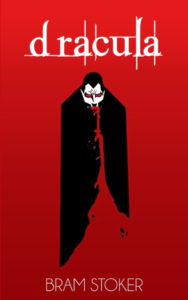 DESCRIPTION FROM AMAZON.com:
DESCRIPTION FROM AMAZON.com:
During a business visit to Count Dracula’s castle in Transylvania, a young English solicitor finds himself at the center of a series of horrifying incidents. Jonathan Harker is attacked by three phantom women, observes the Count’s transformation from human to bat form, and discovers puncture wounds on his own neck that seem to have been made by teeth.
Harker returns home upon his escape from Dracula’s grim fortress, but a friend’s strange malady — involving sleepwalking, inexplicable blood loss, and mysterious throat wounds — initiates a frantic vampire hunt. The popularity of Bram Stoker’s 1897 horror romance is as deathless as any vampire. Its supernatural appeal has spawned a host of film and stage adaptations, and more than a century after its initial publication, it continues to hold readers spellbound.
REVIEW AS AN AUTHOR: I usually start with my review as a reader but today I have to start with my review as an author. I have read this book at least twice, maybe even more, and find the story wonderful — but only because I’ve seen movies that stuck very closely to the storyline.
I usually start with my review as a reader but today I have to start with my review as an author. I have read this book at least twice, maybe even more, and find the story wonderful — but only because I’ve seen movies that stuck very closely to the storyline.
I found the technique of telling the story through a series of letters VERY CONFUSING. Extremely confusing. Reading through the letters as a reader, it is enjoyable and they do add to the element of suspense and a low-grade horror that continues through the book. However, after reading the book several times, I would never have been able to give an account of who everyone was and where they all went in the story. That was all too elusive with going back and forth between the letters from different people and then back to the narrative itself.
SPOILER ALERT – QUICK SYNOPSIS OF THE PLOTLINE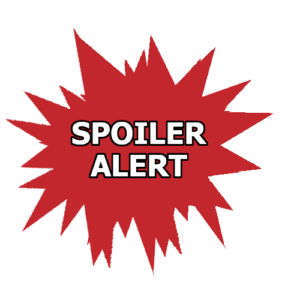 So for anyone who wants to see the action laid out quickly, read below. There are spoilers, so don’t read this part if you don’t want to spoil the book plot for yourself. I personally don’t care about spoilers as sometimes I enjoy books or movies better when I know ahead of time what to watch for!
So for anyone who wants to see the action laid out quickly, read below. There are spoilers, so don’t read this part if you don’t want to spoil the book plot for yourself. I personally don’t care about spoilers as sometimes I enjoy books or movies better when I know ahead of time what to watch for!
That being said, here is a quick synopsis of what happens with the actual itinerary:
Harker goes to Dracula’s castle in the Carpathian Mountains. Dracula is weird and there are women there that attack him. He winds up sick and unconscious in a hospital in Budapest.Dracula takes a ship called the Demeter to England where he has purchased an estate house. He brings several boxes of earth from his homeland, Transylvania.The captain of the Demeter leaves a log behind which narrates how all the crew disappear or end up dead one at a time. At some point, he is alone, he binds himself to the ship/mast, and he arrives in port in England dead too.Lucy Westenra and Mina Murray are best friends. Lucy writes to Mina telling her she has been proposed to by three men: Dr. John Seward, Quincey Morris and Arthur Holmwood. She chooses Holmwood but they all remain friends.Lucy invites Mina on vacation with her. Since Jonathan has gone to deliver real estate papers to Dracula, she joins Lucy on holiday in Whitby, which is where Dracula’s ship lands.Mina then receives a letter about her fiancé’s illness (Jonathan Harker) and she travels to Budapest to nurse him.While she’s gone, Lucy begins sleepwalking while still away in Whitby. Dracula stalks Lucy. Lucy becomes very ill but no one knows why.Professor Abraham Van Helsing comes to diagnose Lucy but he refuses to disclose the real reason for her illness. Instead, he diagnoses her with acute blood-loss. Van Helsing places garlic flowers around Lucy’s sick room and makes her a necklace of them. Her mother, who has no idea they are to ward off vampires, innocently removes them from Lucy and from the room.A wolf then shows up and terrifies Lucy and her mother. Mrs. Westenra dies of a heart attack. Then Lucy dies shortly thereafter.After Lucy’s burial, newspaper reports children being stalked in the night by a beautiful woman and Dr. Van Helsing deduces it is Lucy who has now arisen as a vampiress. He decides he has to do something.The four men (Van Helsing, Arthur Holmwood, Dr. John Seward, and Quincey Morris) go to Lucy’s tomb and see that she is now a vampire. They stake her heart, behead her, and fill her mouth with garlic. Lucy as a vampiress is now taken care of. The men now decide to go after Dracula too.Jonathan Harker and his now-wife Mina have returned to England and they join the campaign against Dracula.As they go off to hunt Dracula, they stay at Dr. Seward’s asylum. Van Helsing finally reveals to them that vampires can only rest on earth from their homeland.Dracula communicates with Sewart’s patient, Mr. Renfield, an insane man who eats flies, vermin, and birds to absorb their life force. He learns of the men’s plot against him and he uses Renfield to enter the asylum.He attacks Mina three times, drinking her blood and forcing her to drink his blood on the final visit. She is now cursed to become a vampire after her death unless Dracula is killed.After a search, the men find Dracula’s properties and they find many boxes of dirt (Transylvania earth) within. They open each box of earth and seal pieces of consecrated Catholic Hosts, sacramental bread, inside each box, now rendering them useless to Dracula.They try to trap the Count in his Piccadilly house but he escapes. They learn he is fleeing back to his castle in Transylvania with his last box of dirt.Van Helsing, knowing Mina still has at least a psychic connection to Dracula, hypnotizes her to track Dracula’s whereabouts on his escape route.In Galatz Romania, the group splits up. Dr. Van Helsing and Mina go to Dracula’s castle where the professor destroys the vampiresses.Jonathan Harker and Arthur Holmwood go off to find Dracula’s boat on the river, while Quincey Morris and John Seward parallel them on the land on the river bank.They find the box and once Dracula’s coffin is loaded onto a wagon by Romani men, the hunters converge and attack it. There is a big fight with the Romani men and Quincy is wounded.After catching up with the others, Harker decapitates Dracula as Quincy stakes him in the heart. Dracula crumbles to dust, freeing Mina from her vampiric curse.Quincy is mortally wounded in the fight against the Romani. He dies at peace knowing that Mina will be okay.Seven years later, there is a note indicating that the Harkers now have a son named Quincey.WHAT WAS GREAT ABOUT THE BOOK:Now that I got my negative review about telling a story with letters out of the way, I’ll go into what is great about the book. First of all, the story was so original. Even today, the story maintains its originality in it’s prose, it’s atmosphere and the storyline itself. It has lost nothing over the years. It reads as a historical novel, but it does not read as dated one bit.
As an author, I read in awe of Bram Stoker. There was no vampire genre at the time. There were similar horror-like creatures written about before Bram Stoken wrote this story, but in my humble opinion, 95% of his story is unique and pulled entirely from his imagination. This is why although there may have been one or two books written before his, Dracula is the one that kickstarted the entire vampire genre.
On top of the horror story about Dracula, the mini story about the mental patient Renfield could have been a follow-up book. It too was so original, fascinating, a classic horror tale.
Although I didn’t like the narrative device of using letters, the story itself was five stars. It was and still is a classic gothic vampire story. It contains all of the scary, errie, weird, unsettling, suspenseful and horrific elements, none of which are dated or have lost one bit of their effect. I have listed below some of my favorite turn of phrases and I hope you enjoy them.
IF I HAD TO READ THIS AGAIN:If I had to or chose to read this book again, which I will, I would read through the narrative I pieced together above — from my own book notes and the help of Wikipedia for proper names — before starting out. This is another instance where I think a list of characters in the beginning of the novel would be helpful to the reader.
If the reader removes the job of trying to keep whose letters one is reading and what is happening before or simultaneously, it would make the story much more enjoyable.
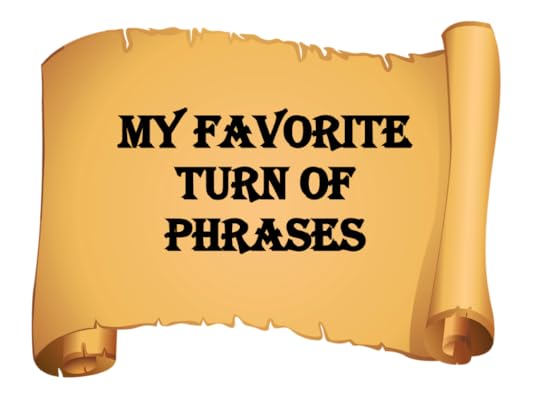 MY FAVORITE TURN OF PHRASES:The road was rugged, but still we seemed to fly over it with a feverish haste.The dog began to howl somewhere in a farmhouse far down the road — a long, agonized wailing, as if from fear.At the first howl, the horses began to strain and rear, but the driver spoke to them soothingly, and they quieted down, but shivered and sweated as though after a runaway from sudden fright.Then, far off in the distance, from the mountains on each side of us began a louder and a sharper howling — that of wolves — which affected both the horses and myself in the same way — for I was minded to jump from the caleche and run, whilst they reared again and plunged madly, so that the driver had to use all his great strength to keep them from bolting.Blazed with a demonic fury . . .Made a grab at my throatThis describes the last seaman who was found on the ship: The searchlight followed her (the ship), and a shudder ran through all who saw her, for lashed to the helm was a corpse, with drooping head, which swung horribly to and fro at each motion of the ship.
MY FAVORITE TURN OF PHRASES:The road was rugged, but still we seemed to fly over it with a feverish haste.The dog began to howl somewhere in a farmhouse far down the road — a long, agonized wailing, as if from fear.At the first howl, the horses began to strain and rear, but the driver spoke to them soothingly, and they quieted down, but shivered and sweated as though after a runaway from sudden fright.Then, far off in the distance, from the mountains on each side of us began a louder and a sharper howling — that of wolves — which affected both the horses and myself in the same way — for I was minded to jump from the caleche and run, whilst they reared again and plunged madly, so that the driver had to use all his great strength to keep them from bolting.Blazed with a demonic fury . . .Made a grab at my throatThis describes the last seaman who was found on the ship: The searchlight followed her (the ship), and a shudder ran through all who saw her, for lashed to the helm was a corpse, with drooping head, which swung horribly to and fro at each motion of the ship.CROSSWORD BASED ON DRACULA BY BRAM STOKER:
July 11, 2024
How Can Taking a Creative Break Renew Your Energies? Free Coloring Book Page
 Sick woman at work with headache
Sick woman at work with headacheWhile writing a novel, or just in today’s fast-paced work environment, we often find ourselves buried under a mountain of tasks, deadlines, and responsibilities. A feeling of being overwhelmed by your how-to lists can happen, zapping what’s left of your daily energies.
Just like a cluttered workspace, a crammed mind can hinder creativity. A break allows your brain to hit pause, letting go of unproductive thoughts and making space for fresh ideas.
Clear the cobwebs out of your mind. It’s important to take a step back to recharge your batteries. One effective way to do this is by incorporating creative breaks into your daily routine.
TAKE A BREAK AND COLOR SOMETHING OR ADD A PAGE TO A SCRAPBOOK: When you immerse yourself in a creative activity, you allow your mind to wander and explore new ideas. This mental freedom can shake off your daily work enough to give you a respite from things.
When you immerse yourself in a creative activity, you allow your mind to wander and explore new ideas. This mental freedom can shake off your daily work enough to give you a respite from things.
By delving into another unrelated creative endeavor, it can also give your mind a chance to operate on its own. Be amazed at how new ideas will come to you regarding your daily work, including new strategies or shortcuts to help you get a better handle on things.
By setting your mind free to create something that has no deadline and no boss, you will create your own respite, a resting place to completely clear your mind.
THE RETURN OF MENTAL CLARITY: After just a short hour or so of this creative activity, your mind will be clear. You will begin again with a rested mind, a mind that has been on a creative journey and will bring with it renewed energies and even new and better ideas.
After just a short hour or so of this creative activity, your mind will be clear. You will begin again with a rested mind, a mind that has been on a creative journey and will bring with it renewed energies and even new and better ideas.
This respite will also reduce stress and anxiety. Even if you add this respite and need to make it up on the other end, it can still make your work more enjoyable. It can whisk you away from that point where you want to pull your hair out.
TRY IT – HERE IS A COLORING PAGE OF A CAT WITH FLOWERS.
Click on image to download a pdf from Google Drive
Making Money Online – Earn more money with your typing
 The answer to this questions is how fast you can type, what you’re typing, and what else you do besides typing. Basic typing would be considered ‘data entry’ and this is considered an entry level skill level. You won’t make much money by just copying something and typing it into a computer system.
The answer to this questions is how fast you can type, what you’re typing, and what else you do besides typing. Basic typing would be considered ‘data entry’ and this is considered an entry level skill level. You won’t make much money by just copying something and typing it into a computer system.
However, if you can add just a few extra skills to your typing skills, you can double or triple your salary.
HOW TO QUICKLY UPGRADE YOUR TYPING TO AN ADVANCED SKILL:One rank up from data entry is secretarial. So if you can develop telephone
 Young beautiful woman with laptop
Young beautiful woman with laptopskills and a workable message system, you can move into a secretarial job with very little additional education. This would require the ability to take messages, keep a running log of them, and deliver them to whoever needs to receive them.
Often there could be an additional task or two that you will need to perform based on whatever business you enter, but it’s nothing that you will need extra training for.
Once you have experience in secretarial, you can climb up to administrative assistant and even up to legal assistant and that is where you will double and/or triple your salary.
FOUR OF THE MAIN JOB AREAS WHERE TYPING IS A STAPLE:1. Data Entry:
Accurately entering and updating data into databases and information systemsMaintaining data quality and consistency (checking errors)Verifying and correcting data errorsFollowing data entry procedures and guidelines. Each office has their own procedures,Working efficiently to meet deadlines. For this you will need a good tickler system.May involve using specific data entry software such as Word or Google Sheets, or even one unique to the business you will be working with2. Secretarial:
Providing scheduling and calendar management for executives or teamsAnswering phones, taking messages, and directing callsComposing and formatting business letters, emails, and reports. Often this will entail listening to audiotapes and typing from them.Proofreading and editing documentsManaging travel arrangements — nothing you can’t learn from watching about 10 YouTube videosPreparing presentations and meeting materials. This could entail using PowerPoint or some other software. This would not be expected in an entry level position.Maintaining office supplies and equipment.3. Administrative Assistant:
Providing general administrative support to a department or executive. Be sure to see my next blog post about analyzing the job you just got!Managing calendars and scheduling appointments.Composing and formatting business documentsAnswering phones and emailsOrganizing and maintaining filing systemsPreparing presentations and meeting materialsBooking travel and making arrangementsPerforming research and compiling reportsMay involve social media management or light bookkeeping tasks4. Legal Assistant:
 Assisting lawyers with legal research and case preparation. This would require a bit of additional study from an administrative job, but nothing you can’t self-study.Drafting legal documents (e.g., motions, letters, pleadings)Managing and organizing legal files and documentsScheduling appointments and meetings with clients and attorneysCommunicating with clients and court personnelPreparing legal correspondenceMaintaining confidentiality of client informationMay involve legal research databases and online court filing systemsQUICKEST UPGRADE IN A TESTING FIELD:
Assisting lawyers with legal research and case preparation. This would require a bit of additional study from an administrative job, but nothing you can’t self-study.Drafting legal documents (e.g., motions, letters, pleadings)Managing and organizing legal files and documentsScheduling appointments and meetings with clients and attorneysCommunicating with clients and court personnelPreparing legal correspondenceMaintaining confidentiality of client informationMay involve legal research databases and online court filing systemsQUICKEST UPGRADE IN A TESTING FIELD:You can test out your a new position by becoming a ‘virtual assistant’ on Fiverr.com. This way you can test out and get basic experience in doing many of the tasks you will need to do in a secretarial and/or administrative assistant job.
July 10, 2024
Book Review – Pride and the Peacock by Victoria Holt
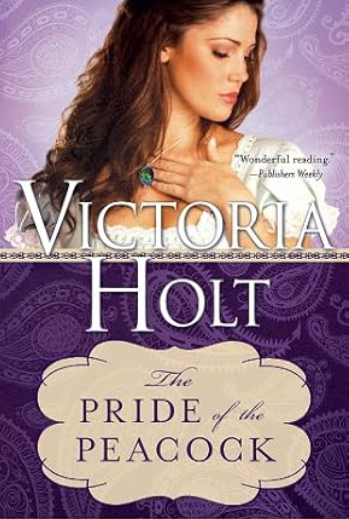 Amazon Description of the Book:
Amazon Description of the Book:
A young woman uncovers her family’s dark secrets in this mystery and her connection to a famously cursed gemstone in this Victorian gothic thriller from an internationally bestselling author
To secure her inheritance, Jessica Clavering agrees to a marriage of convenience, but will her handsome new husband’s desire for her ever surpass his obsession with a famously cursed opal?
Raised in the shadow of her family’s financial ruin, Jessica has never felt as though she fit in. When her only friend, an elderly neighbor, offers her the chance at a new life, she’s eager to take it. His only condition: she must marry her son, Joss.
The newlyweds inherit a fabled opal mine in Australia. It’s only once they arrive on the faraway continent that Jessica starts to uncover her family’s dark past and her connection to the Green Flash, an exquisite and spellbinding opal. The stone arouses a dangerous desire in anyone who sees it—even her husband.
Blending historical romance with elements of the paranormal, The Pride of the Peacock is an exhilarating tale from the Queen of Gothic Romance. Fans of Susanna Kearsley, Daphne Du Maurier, and Kate Morton will be spellbound by classic story of an overseas voyage, a cursed opal, and forbidden desire.
MY REIVEW AS AN AUTHOR:This was the second Victoria Holt Gothic book I read. I loved this one as well. I can see that the her style is formulaic — but in a good way. She includes all of the elements of a great gothic story: A large house, a story weaving around the wealthy vs. a lower caste in society, a family secret, a mysterious question arises that weaves all the way through the story. As an author, I could see the formula, but it didn’t take away from the enjoyment of the story, not one bit.
This story included a journey into the world of opal minors and it gave the reader a historical view and close up view of the life of an opal minor. This was the educational part of the plot, and it was very enjoyable. I would never have chosen to read a magazine article about mining for opals, but the way Ms. Holt weaved it into the story added a depth to the story and gave the reader the experience of entering a different world.
Her writing style was just as beautiful as the first novel. I found myself watching what verbs she chose to use, and how she described her scenes. I learned a lot about weaving descriptions into the storyline. Below I have a few of my favorite ‘turn of phrases’.
I don’t want to go into the storyline too deeply, but it was a story of a young woman who saved the life of a neighbor, who is intricately involved in her family in ways she has no idea of in the first half of the story. She learns about this connection one secret at a time, and her fate is also taken up by the man she saved.
I went through my notes after reading the book and put together a crossword puzzle for anyone who also read the book and wants to try their hand at it. I used mostly the words I either had never heard before or had to look up! Below, I will speak to the gothic issues that we are all interested in.
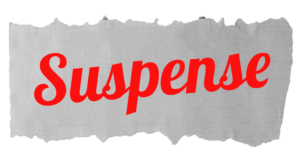 SUSPENSE: For suspense, I give this a nine out of ten. This story twisted and turned in a few different directions, enough to keep me reading chapter after chapter, long after I planned to put the book down.
SUSPENSE: For suspense, I give this a nine out of ten. This story twisted and turned in a few different directions, enough to keep me reading chapter after chapter, long after I planned to put the book down.
PLOTTING: I give this book a perfect 10 too. The story and relationships were well planned. The clues were dropped into the storyline in a way that kept the reader — and the main character — guessing. Just when you thought you had figured out where the story was going, there was a plot twist.
GOTHIC ELEMENTS: I give the story an 7 out of 10, not because it was lacking anything. This is more of a rating based on how gothic the story was in it’s setting and timeframe. Dracula would get a 10 in gothic elements, but this story was less than that level of dark or scary. I would say it was more of a gothic intrigue. I would give it a 10 in gothic intrigue.
CLARITY OF WRITING: I give this book a perfect 10 just like the last one. There was never a time when I had to re-read the story to figure out who was talking or what was going on. The story was quite intricate, but Victoria Holt’s writing style is so crisp and clear, the reader is never abandoned on the page. It was easy to read and clearly written. The editing and grammar were perfect.
PROSE: I give this book a perfect 10 again because she is a master at writing prose. I read a bit about the author’s story and she wrote for many years and wrote I think well over a hundred books or more, so she rose to the top in my opinion. I enjoyed every page of this book, just as I did the last book.
I have even chosen another Victoria Holt book to read next. I may have found my favorite author!
BELOW ARE MY FAVORITE TURN OF PHRASES:❖ He was an actor of a kind, for when he talked of people his voice and his expression would change.
❖ Hers was an evil sort of beauty. She was what was known as a siren, the sort who would lure men to destruction.
❖ Little eddies of dust swirled just above the ground, and I thought: The wind is certainly rising.
THE CROSSWORD:CROSSWORD – Click on the graphic below to get he google drive file to download. It has the puzzle, the clues as well as the answers (on page 3)
Book Review – Mistress of Mellyn by Victoria Holt
Amazon Description of the Book: Mount Mellyn stood as proud and magnificent as she had envisioned…But what about its master–Connan TreMellyn? Was Martha Leigh’s new employer as romantic as his name sounded? As she approached the sprawling mansion towering above the cliffs of Cornwall, an odd chill of apprehension overcame her.
TreMellyn’s young daugher, Alvean, proved as spoiled and difficult as the three governesses before Martha had discovered. But it was the girl’s father whose cool, arrogant demeanor unleashed unfamiliar sensations and turmoil–even as whispers of past tragedy and present danger begin to insinuate themselves into Martha’s life.
Powerless against her growing desire for the enigmatic Connan, she is drawn deeper into family secrets–as passion overpowers reason, sending her head and heart spinning. But though evil lurks in the shadows, so does love–and the freedom to find a golden promise forever…

I loved this book and everything about it. There was a mystery at the core of the story, but at the same time, this was a family drama that played out among several interesting characters. It was a love story, but it was also a gothic story. It had all the elements of a gothic novel, and took me away as a reader to another time and place.
Although it was a classic gothic novel and had all the elements — spooky house, odd suspicious characters at every turn — there was also a mystery that the main character was trying to solve the entire story. This made the story all the more enjoyable.
MY REIVEW AS AN AUTHOR:I got so much out of this book being an author myself. It was intricately plotted and executed with mastery. I was in awe of the author’s talent as a writer. It held my interest the whole way through.
Part of the story was a bit educational about the historical times and I personally love when an author adds this level to the book — but also knows where to stop. Victoria Holt had the perfect mix.
Her writing style is beautiful. I was in awe of it the entire way through. There was another almost poetic turn of phrase on each page.
I don’t want to go into the storyline itself other than to say it was the story of a young woman who is chosen to be a governess at a time and place when being a governess was considered a ‘lower class’.
I went through my notes after reading the book and put together a crossword puzzle for anyone who also read the book and wants to try their hand at it. I used mostly the words I either had never heard before or had to look up!
 SUSPENSE: For suspense, I give this an eight out of ten. It was very suspenseful, but I wouldn’t call it a suspense book. It had a ribbon of suspense throughout the book which added very much to the gothic novel.
SUSPENSE: For suspense, I give this an eight out of ten. It was very suspenseful, but I wouldn’t call it a suspense book. It had a ribbon of suspense throughout the book which added very much to the gothic novel.
PLOTTING: I give this book a perfect 10. The story was well planned. There was enough foreshadowing where it didn’t feel like anything was pulled out of a hat at the last minute. The story was complex enough to remain interesting the entire way through, but not over complex where I had to keep notes. This balance and mix made the book completely enjoyable.
GOTHIC ELEMENTS: I give the story an 8 out of 10, not because it was lacking anything. This is more of a rating based on how gothic the story was in it’s setting and timeframe. Dracula would get a 10, but this story was less than that level of gothic. It was the perfect amount for the story that was told.
CLARITY OF WRITING: I give this book a perfect 10. There was never a time when I had to re-read to try to figure out who was talking or where everyone was. It was easy to read and clearly written. The editing and grammar were perfect.
PROSE: I give this book a perfect 10 here too because I love Victoria Holt’s style of writing and her style of storytelling. I literally enjoyed every page of the book.
BELOW ARE MY FAVORITE TURN OF PHRASES:❖ We climbed to the plateau and a pair of intricately wrought-iron gates confronted us.
❖ This was a phrase I never heard before and I was not even able to find a definition on the internet. If anyone knows what this means, please let me know! there was a whatnot in . . .
❖ I deliberately bearded you in your carriage . . .
❖ dangerously demure
❖ tomb of a place
CROSSWORD – Click on the graphic below to get he google drive file to download. It has the puzzle, the clues as well as the answers (on page 3)

July 5, 2024
Emergency Supplies & Preparation – Part 2
After a lot of research over several years, and living through several Florida hurricanes, I came to the following conclusions about emergency preparation and the best way to prepare for food shortages.
Second freezers vs. Canning Foods: This freezer is from Amazon and it is approximately $179. They come in all sizes and all price ranges. However, if the electricity goes off for a few hours, it is virtually impossible to save frozen foods. No matter how many second freezers you have with extra food, they will all spoil at the same time. And eating everything in the freezer is not going to do anything for you except make you too full and maybe get sick.
This freezer is from Amazon and it is approximately $179. They come in all sizes and all price ranges. However, if the electricity goes off for a few hours, it is virtually impossible to save frozen foods. No matter how many second freezers you have with extra food, they will all spoil at the same time. And eating everything in the freezer is not going to do anything for you except make you too full and maybe get sick.
On top of that, there’s an emotional toll watching all of your food go bad one minute at a time takes on you. No matter how many bags of ice you buy and how many Styrofoam chests you get, you won’t be able to keep up with the food spoilage. I know, I’ve been there. You’ll be lucky if you save some coffee milk.
Buying food on sale and keeping it in a freezer is a great hedge against inflation. That’s where having an extra freezer or two can really pay off, especially in times when inflation is getting worse every week. But if you anticipate being in a situation where you there electricity may go off, then you will wish your food was canned.
PRESSURE CANNING:
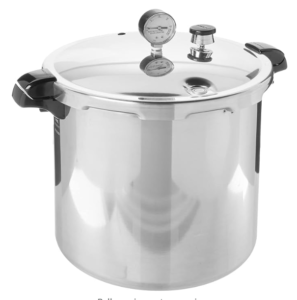
Investing in a Pressure Canner is much cheaper than the cheapest refrigerator. This canner, which is the one I have, is only $131 dollars. I have canned meat in this many, many times.
I got into canning when signs of civil unrest became too great to ignore. By watching YouTube Videos, I have taught myself to can and I mainly can meat. I don’t bother canning vegetables as I believe they will be easier to find during tough times. We have local farms in the area and I even taught myself to grow lettuce, celery and tomatoes. So instead of canning vegetables, I always make sure I have plenty of seeds on hand. I keep them refrigerated.
WHAT DOES CIVIL UNREST LOOK LIKE?Most Americans, including myself, don’t now what war looks like as none of us remember the civil war or the revolutionary war. We also don’t know exactly what happens when civil unrest occurs. However, during the summer after 2020, we saw BLM and Antifa jump into action, and there were fires, riots, looting, cars set on fire, police stations attacked, and even a section of a city was taken over in a few places around the country. That was only a glimpse of what a mob can do when it decides to.
So canning enough food to be able to hide out for a few weeks until the worst of the unrest occurs will be one safety measure you can take. By canning about $120 worth of chicken, you can feed a family for over 30 days — as long as you have pasta or rice to bulk out the meals.
HERE ARE MY OWN TEACHERS:These are two channels I watched and I was able to teach myself how to can chicken, beef and pork. They both have great channels and you’ll enjoy lots of their videos.
CANNING INSTRUCTIONAL:

I will assume that if you are really interested in learning canning that you will watch a few of the above-referenced videos. It’s important to see a few people canning as everyone has their own techniques.
Above are the tools that you will need. The canner and lid. I use one that requires a pressure weight (in the yellow box), canning jars, canning rings and brand new lids. Everything can be reused except the actual lids. So each time you do a new canning session, you can wash and sanitize everything except the lids. They must be new.
 When you buy a package of canning jars, they all come with lids and rings. But once you use those lids, you need to purchase a small package of new lids as shown in the picture above this one.
When you buy a package of canning jars, they all come with lids and rings. But once you use those lids, you need to purchase a small package of new lids as shown in the picture above this one.

I don’t like the way raw chicken or beef looks in the jars, so I always brown my meat just a tiny bit. To do this, I use a small grill that I picked up at Walmart. At the time it was $20. They are probably $25 or $30 now.
HOW LONG OF A CANNING SESSION WOULD BE GOOD FOR YOU?If you’re young, you can do this whole process in one long afternoon. However, if you are over sixty like me, you may be more comfortable breaking this down into two days of work.
DAY 1:On Day 1, I go to the store and buy the chicken at my local Sam’s or Aldi’s in a big family size tray. Then I come home and cut it up into the small 2 inch square pieces. I set up my electric grill and brown the meat just to give it some color.
At the same time, I put 8 empty mason jars into my dishwasher and run it on the sanitize cycle. This cycle takes a while but they will be sanitized and ready to go in the morning.
Once all the chicken has been lightly browned — not cooked, only browned — I put the chicken in a covered container in the refrigerator. I brown the chicken for 2 minutes on each side just to give it a little color. I mention this because the chicken will be “cooking” when being canned for over an hour so thoroughly cooking the chicken at this point is unnecessary.
DAY 2:Then the next morning, I take the chicken out of the refrigerator and place it close by where I’ll be working.
On one stove burner I heat up the water with the bouillon cubes on medium heat and allow them to melt. On another burner, I fill my pressure cooker with the manufacturer’s suggested amount of water. In my pressure canner, it’s about 2.5 inches from the bottom. I set this on medium heat.
As the bouillon cubes are melting, I get the jars out of the dishwasher and line them up next to where I will be working.
Then I run the sink water until it gets really hot. I fill a small saucepan 1/2 way with the very hot tap water. I place the brand new canning tops into the water. This will allow the reddish waxy substance to soften a little and give you a good seal.
Once the bouillon is good and hot, I begin to fill each jar with chicken and then ladle the bouillon over it until it is 1/2 inch from the top. This is where you will use the funnel that comes in the canning tool kit. Then I plunge the air stick, which also comes in the canning kit, into the jar to remove any air bubbles. Once or twice into the jar is good.
Then I wet a paper towel with white vinegar or pour it into a little dish to have beside me. Once you are finished filling each mason jar, use the vinegar soaked paper towel to clean off the top of the mason jar, the area that will touch the new lids. Then using the magnet stick, which also comes in your canning tool kit, take out a top from the hot water and place it onto the top of the new-clean jar. Once the top is on, then twist on a ring and make it finger tight. Finger tight means you would be able to open it without using any arm strength, only finger strength.
Now the jar is ready to add to the canner, with the can mover tool that comes in the kit. The water in the canner will be slowly heating up, so the cold chicken from the refrigerator will get a chance to come up to heat slowly. By placing the jars in the canner one at a time, they will heat the chicken up a little at a time.
Fill all the 7 or 8 jars with chicken and bouillon and place them into the canner. Toss in any extra white vinegar that you poured out and didn’t use. This will prevent your jar contents from getting cloudy.
CLOSE THE CANNER AND BEGIN THE CANNING PROCESS:Then following the manufacturer’s instructions, properly close your canner. There will be instructions on how to create a vacuum. On my particular canner, I need to bring the heat up and allow the canner to heat until there is a stead stream of steam escaping from the top hole on the lid for a full 10 minutes. This allows the canner to work properly.
After the steam escapes for a full ten minutes, then I place the weight on the little stack that sticks out of the top of the pot lid. Then I must watch the canner until it comes to the proper pressure. I live in Florida and canning meat requires 1 hour and 15 minutes at 11 pounds. You will need to check the little book that comes with your canner to find the right pressure for your elevation and area.
The first couple of times, it can get a little tricky to figure out how to keep the pressure at a stead level. I have an electric stove and I need to start my canner on high to get it to get up to 11 pounds. Then I need to put it down to just under half in order to maintain 11 pounds.
I set my cell phone to check it every 15 or 20 minutes to make sure it doesn’t go below 11 pounds. If it goes below your mark, then you have to start over. So when you are first canning, have a chair handy and be ready to watch it like a hawk and even take notes on how your stove works.
TIMINGS FOR FLORIDA:MEAT:
Pints: 75 minutes at #11 (1 hour/15 minutes)
Quarts: 90 minutes at #11
Head Space: 1 inch
CHICKEN WITHOUT BONES:
Pints: 75 minutes at #11 (1 hour/15 minutes)
Quarts 90 minutes at #11 (1 hour/15 minutes)
Head space: 1.25 inch
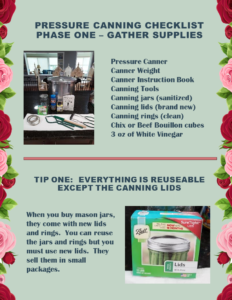
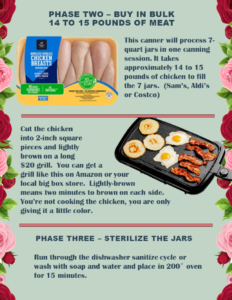
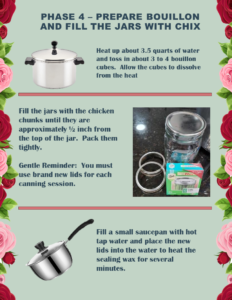
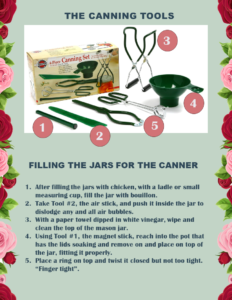
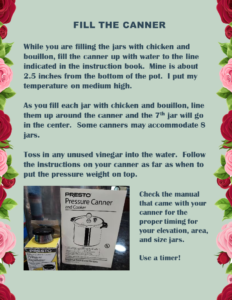
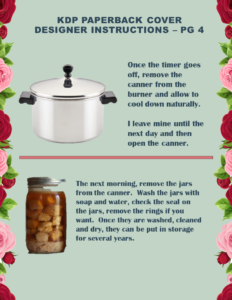
If you want to download the above Canning Instructional, click below:
June 25, 2024
Emergency Supplies & Preparation – Part 1
Everywhere I turn there are economists, political thinkers, ex-military generals all warning about the coming of World War III or some other impending doom. These don’t seem to be people who are just trying to get internet attention, which makes me worry a little.
As an American, I can’t even envision what a war on our soil would look like. And whether we have to worry about an outside invasion, or the invasion of fighting age men who have already arrived, many of us — especially woman — may need to baton down the hatches.
Which raises the issues, what does one need to baton down the hatches?
EMERGENCY WATER SUPPLY:There are rain water supply systems that can be installed alongside your house that cost thousands of dollars and for those of you who have the means, this may be something you want to consider. This would be done by an expert whose whole business is installing these and it would come with all the labor included. I don’t have any idea of what something like this would cost, but I do know it’s an option.
 A second choice is a garden rain barrel system. Now, this doesn’t have to be in a garden, but it has to be somewhere in the open where it can catch rainwater. It can be next to your house or even on a balcony or a cement yard as long as it is able to catch the rain.
A second choice is a garden rain barrel system. Now, this doesn’t have to be in a garden, but it has to be somewhere in the open where it can catch rainwater. It can be next to your house or even on a balcony or a cement yard as long as it is able to catch the rain.
This would be too big for a single woman living alone to handle, in my humble opinion. I’ll cover a system for us next!
THE BUCKET SYSTEM:
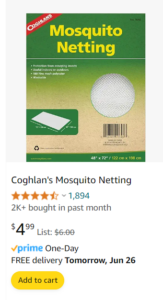
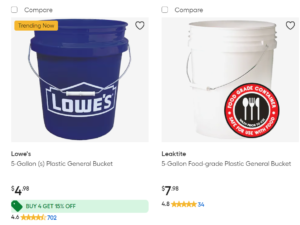
In any true emergency, after several days, people will begin to get desperate. They may begin to roam around looking for these easy-to-spot water barrels with the intention to take them or even take a supply of water for themselves from them.
By using small buckets with a “mosquito netting shower cap” on top, this may be a more stealth way to collect water in not only emergency times, but times of danger.
These buckets can be hidden behind bushes or even placed outside while you are able to watch them a bit. They won’t look as inviting as the more professional systems above — at least that’s my opinion.
These are also more female-friendly as you can more easily move these buckets. A 53 gallon system would be impossible for most females to move without the aid of a husband or other male. It may even be hard for any male to move on his own.
If you get the food grade buckets, you can also put some food in them and you may even feel more comfortable collecting water to drink in them too. These are easy to pick up in any home store and they can be a life saver in times of emergency.
Besides the buckets and mosquito netting, you will also need to pick up 1/4 inch or 1/2 inch elastic that you can tie around the top to hold the mosquito netting in place. They sell this in fabric and craft stores, but the home stores may have a reasonable replacement for this.
FOOD SUPPLIES:I’ve lived through enough hurricanes to know that when the electricity and internet is out, people tend to eat snacks more than anything. However, if the electricity is off for any extended time, you will need to have a stash of food in case there are any emergencies that require you to stay home.
Below is a list of food combinations that will create a “complete protein”. In my next posting, I’ll cover the basics of canning meat, but if you don’t have canned meat, you can create complete proteins by combining the following foods:
Rice & Beans – Individually, rice and beans lack certain essential amino acids, the building blocks of protein. Rice is low in lysine but high in methionine. Beans are high in lysine but low in methionine.
When eaten together, they complement each other. Rice provides the lysine beans lack, and beans provide the methionine rice lacks.
This combination creates a protein source with all nine essential amino acids, making it a “complete protein.
Below are other combinations that work together in the same way:
Brown rice with peanuts or almonds.Whole-wheat crackers with sunflower seedsQuinoa with pumpkin seedsCorn and Beans: A classic combo in many cultures, like corn tortillas with beans or succotash (corn and lima beans)Peanuts and Whole-Wheat Bread: A peanut butter sandwich on whole wheat bread is a complete protein sourceSoy products: Tofu, tempeh, edamame, and miso are all excellent sources of complete plant-based protein.Certain whole grains: Quinoa, buckwheat, and amaranth are all considered complete protein sources on their own.Seeds: Hemp seeds, chia seeds, and nutritional yeast are all good sources of complete proteinEggs: Scrambled eggs with chopped red potatoes or a potato omelet would create a complete protein dishOatmeal with nuts and seedsOatmeal and milk or yogurtOatmeal with Almond milk and sliced bananaOatmeal with a scoop of protein powder and a fruitLET’S HOPE THIS WILL ALL BE UNNECESSARY:In mid-June of 2024, Russia moved a fleet of warships into the waters off Cuba. The alleged purpose of these warships is to conduct military exercises in the Caribbean Sea. This move by Russia was seen by some as a show of force amid heightened tensions between Russia and the West due to the war in Ukraine. PBS News.
These warships reportedly included:
A frigate (Dictionary: “any of various types of modern naval vessels ranging in size from a destroyer escort to a cruiser, frequently armed with guided missiles and used for aircraft carrier escort duty, shore bombardment, and miscellaneous combat functions.”)A nuclear-powered submarineAn oil tankerA rescue tug AP NewsLet’s hope this is only saber-rattling of some kind and that it will be resolved in some peaceful way. I live in Florida, and the craziness is getting a little too close for me. It’s time to hope for the best but prepare for the worst.
Emergency Supplies –
Everywhere I turn there are economists, political thinkers, ex-military generals all warning about the coming of World War III or some other impending doom. These don’t seem to be people who are just trying to get internet attention, which makes me worry a little.
As an American, I can’t even envision what a war on our soil would look like. And whether we have to worry about an outside invasion, or the invasion of fighting age men who have already arrived, many of us — especially woman — may need to baton down the hatches.
Which raises the issues, what does one need to baton down the hatches?
EMERGENCY WATER SUPPLY:There are rain water supply systems that can be installed alongside your house that cost thousands of dollars and for those of you who have the means, this may be something you want to consider. This would be done by an expert whose whole business is installing these and it would come with all the labor included. I don’t have any idea of what something like this would cost, but I do know it’s an option.
 A second choice is a garden rain barrel system. Now, this doesn’t have to be in a garden, but it has to be somewhere in the open where it can catch rainwater. It can be next to your house or even on a balcony or a cement yard as long as it is able to catch the rain.
A second choice is a garden rain barrel system. Now, this doesn’t have to be in a garden, but it has to be somewhere in the open where it can catch rainwater. It can be next to your house or even on a balcony or a cement yard as long as it is able to catch the rain.
This would be too big for a single woman living alone to handle, in my humble opinion. I’ll cover a system for us next!
THE BUCKET SYSTEM:


In any true emergency, after several days, people will begin to get desperate. They may begin to roam around looking for these easy-to-spot water barrels with the intention to take them or even take a supply of water for themselves from them.
By using small buckets with a “mosquito netting shower cap” on top, this may be a more stealth way to collect water in not only emergency times, but times of danger.
These buckets can be hidden behind bushes or even placed outside while you are able to watch them a bit. They won’t look as inviting as the more professional systems above — at least that’s my opinion.
These are also more female-friendly as you can more easily move these buckets. A 53 gallon system would be impossible for most females to move without the aid of a husband or other male. It may even be hard for any male to move on his own.
If you get the food grade buckets, you can also put some food in them and you may even feel more comfortable collecting water to drink in them too. These are easy to pick up in any home store and they can be a life saver in times of emergency.
Besides the buckets and mosquito netting, you will also need to pick up 1/4 inch or 1/2 inch elastic that you can tie around the top to hold the mosquito netting in place. They sell this in fabric and craft stores, but the home stores may have a reasonable replacement for this.
FOOD SUPPLIES:I’ve lived through enough hurricanes to know that when the electricity and internet is out, people tend to eat snacks more than anything. However, if the electricity is off for any extended time, you will need to have a stash of food in case there are any emergencies that require you to stay home.
Below is a list of food combinations that will create a “complete protein”. In my next posting, I’ll cover the basics of canning meat, but if you don’t have canned meat, you can create complete proteins by combining the following foods:
Rice & Beans – Individually, rice and beans lack certain essential amino acids, the building blocks of protein. Rice is low in lysine but high in methionine. Beans are high in lysine but low in methionine.
When eaten together, they complement each other. Rice provides the lysine beans lack, and beans provide the methionine rice lacks.
This combination creates a protein source with all nine essential amino acids, making it a “complete protein.
Below are other combinations that work together in the same way:
Brown rice with peanuts or almonds.Whole-wheat crackers with sunflower seedsQuinoa with pumpkin seedsCorn and Beans: A classic combo in many cultures, like corn tortillas with beans or succotash (corn and lima beans)Peanuts and Whole-Wheat Bread: A peanut butter sandwich on whole wheat bread is a complete protein sourceSoy products: Tofu, tempeh, edamame, and miso are all excellent sources of complete plant-based protein.Certain whole grains: Quinoa, buckwheat, and amaranth are all considered complete protein sources on their own.Seeds: Hemp seeds, chia seeds, and nutritional yeast are all good sources of complete proteinEggs: Scrambled eggs with chopped red potatoes or a potato omelet would create a complete protein dishOatmeal with nuts and seedsOatmeal and milk or yogurtOatmeal with Almond milk and sliced bananaOatmeal with a scoop of protein powder and a fruitLET’S HOPE THIS WILL ALL BE UNNECESSARY:In mid-June of 2024, Russia moved a fleet of warships into the waters off Cuba. The alleged purpose of these warships is to conduct military exercises in the Caribbean Sea. This move by Russia was seen by some as a show of force amid heightened tensions between Russia and the West due to the war in Ukraine. PBS News.
These warships reportedly included:
A frigate (Dictionary: “any of various types of modern naval vessels ranging in size from a destroyer escort to a cruiser, frequently armed with guided missiles and used for aircraft carrier escort duty, shore bombardment, and miscellaneous combat functions.”)A nuclear-powered submarineAn oil tankerA rescue tug AP NewsLet’s hope this is only saber-rattling of some kind and that it will be resolved in some peaceful way. I live in Florida, and the craziness is getting a little too close for me. It’s time to hope for the best but prepare for the worst.
June 24, 2024
Scrivener – Creating a Theme, Downloading a Theme and Importing a Theme
HOW TO CHANGE SCRIVENER'S DEFAULT THEME:
The first thing you need to do is click on File => Options. It's down at the bottom of the options list under the File Tab. There is a picture to the right.
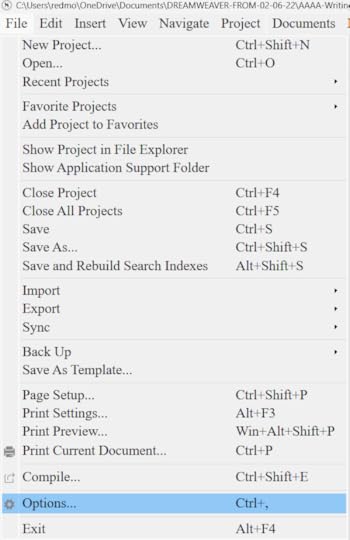
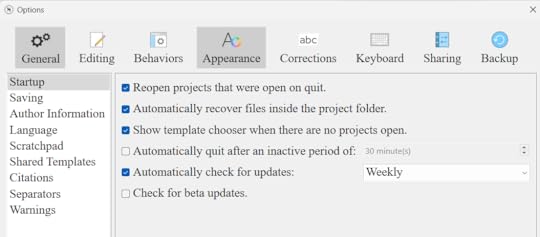
This will open a dialogue box. Choose the Appearances Tab. You can see it in the second picture above.
June 19, 2024
Organizing Information for an Infographic
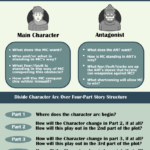 I’ve always found that infographics can give you an instant bird’s eye view of any information, system, or strategy that makes understanding the information so much easier.
I’ve always found that infographics can give you an instant bird’s eye view of any information, system, or strategy that makes understanding the information so much easier.
I’ve also found that organizing information in a way to make an infographic is a good way to actually study a subject. Most of the style of infographics come from color, symbols, icons, and shapes. The test of it is made up on bis and pieces of organized information.
INFOGRAPHICS AS A WAY TO LEARN INFO: The last few times I was wrestling with learning something, I “took notes” and then organized them into an infographic or two. What I found was that the process was easier than I thought.
The last few times I was wrestling with learning something, I “took notes” and then organized them into an infographic or two. What I found was that the process was easier than I thought.
After analyzing what makes an infographic, I realized that it all starts with the organized information set up in some kind of hierarchy, sectioning or divisions
Once you know how many containers of information you will need, your design begins there. The rest of it is color choice, container sizes and shapes, and whatever illustrations, charts or icons you want to use to dress it up.
INFOGRAPHICS AS A WAY TO PASS ON WHAT YOU’VE LEARNED: Once you are done, you know the material much better. And with an infographic now in your hands, it’s easy enough to pass it on. People love to have easy-to-understand information or directions at their fingertips!
Once you are done, you know the material much better. And with an infographic now in your hands, it’s easy enough to pass it on. People love to have easy-to-understand information or directions at their fingertips!
If you would like to download an infographic about organizing information for infographics, sign up below. This list only gets one email newsletter a month with other infographics, sales, deals and steals.








